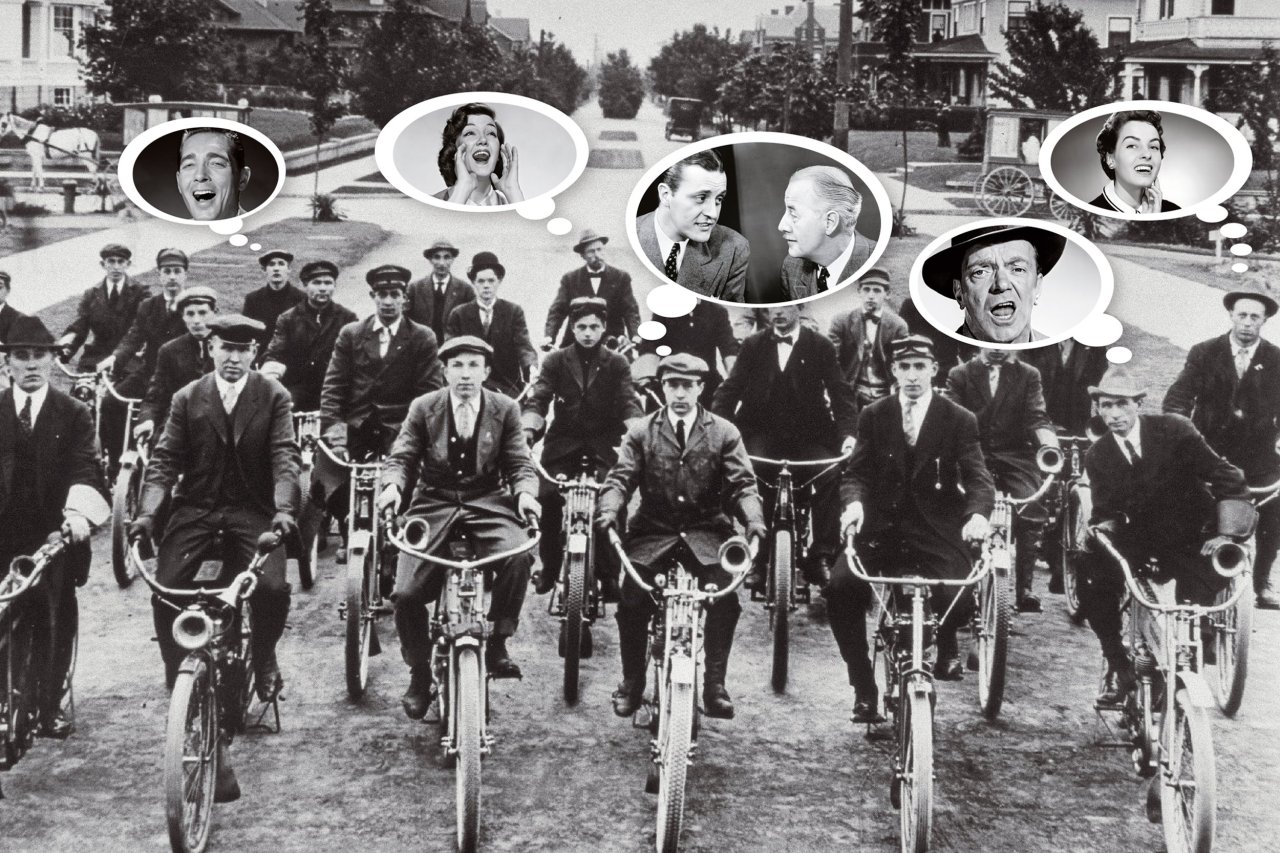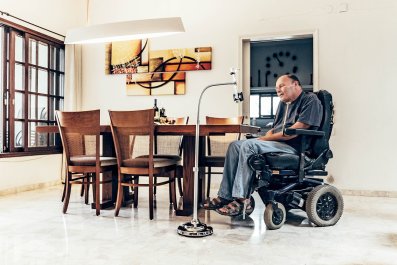One night, during her first year at the University of Sheffield, Rachel Waddingham struggled to fall asleep. She could hear three middle-aged men she didn't know talking about her in another room. "They were saying, 'She's stupid, she's ugly, I wish she would kill herself,'" she says. "I was angry and went downstairs to challenge them, but no one was there. They kept laughing and saying, 'She'll never find us.'"
The voices became a recurring presence, providing an aggressive, unsettling commentary on her life. Waddingham came to believe they were filming her around the clock, and she became paranoid. When she had a neck ache, she assumed a tracking device had been planted under her skin. At the supermarket, the voices would ask each other questions like "Does she know what she's buying?"—leading Waddingham to reach sinister conclusions. "I worried they might have poisoned the food," she says. "I'd come back with orange juice, milk, bread and cheese, because it's all I could work out was safe."
Waddingham turned to alcohol to cope, and avoided friends because she feared "The Three" would secretly film them as well. Months later, she dropped out of the university and moved into a bedsit (similar to a single-resident-occupancy building in the U.S.), too afraid to eat or bathe. A doctor eventually admitted her into a psychiatric hospital, where she was diagnosed with schizophrenia and put on a cocktail of drugs. During her eight months in the hospital, the voices faded, but the side effects of the medication made life intolerable. Waddingham gained more than 65 pounds and developed diabetes. Her eyes would roll involuntarily, and she struggled with akathisia, an overwhelming sense of restlessness that caused her to shuffle from foot to foot. Suicide attempts followed, and she felt "like a walking zombie." But because she was no longer hearing the voices, she was released from the hospital.
Waddingham is still on meds today, but has been slowly weaning herself off of them for years. Her long-term goal is to end her reliance on medication entirely.
Life With the Not-Yets
Research suggests that up to 1 in 25 people hears voices regularly and that up to 40 percent of the population will hear voices at some point in their lives. But many live healthy and fulfilling lives despite those aural specters.
In October, Waddingham and more than 200 other voice-hearers from around the world gathered in Thessaloniki, Greece, for the sixth annual World Hearing Voices Congress, organized by Intervoice, an international network of people who hear voices and their supporters. They reject the traditional idea that the voices are a symptom of mental illness. They recast voices as meaningful, albeit unusual, experiences, and believe potential problems lie not in the voices themselves but in a person's relationship with them.
"If people believe their voices are omnipotent and can harm and control them, then they are less likely to cope and more likely to end up as a psychiatric patient," says Eugenie Georgaca, a senior lecturer at the Aristotle University of Thessaloniki and the organizer of this year's conference. "If they have explanations of voices that allow them to deal with them better, that is a first step toward learning to live with them."
The road to this form of recovery often begins in small support groups run by the Hearing Voices Network (HVN). The first group formed in the Netherlands in 1987, and, since then, others have cropped up in 30 countries, including Bosnia, Canada, Japan, Tanzania and the U.S. Members share their stories and coping mechanisms—for example, setting appointments to talk with the voices, so the voice-hearer can function without distraction the rest of the day. Above all, these groups give voice-hearers a sense of community where they can be seen as people rather than patients.
A central premise of HVN is that these voices frequently emerge following extreme stress or trauma. Research bears that out: At least 70 percent of voice-hearers are thought to have experienced some form of trauma. The characteristics of voices vary widely from person to person, but the voices often mimic the sound and language of abusers. In other instances, they may personify characteristics of the victim at the time of his or her abuse. The voices can be demonic and frightening, angelic and friendly, and take every form in between.
Waddingham, for instance, now hears 13 voices. Among them are Blue, a frightened but cheeky 3-year-old; Elfie, an angry teenager; Tommy, a teenage boy who criticizes her speech; the Scream, a female voice filled with pain and suffering ("When I first heard her, I felt so overwhelmed I was unable to leave the house"); and the Not Yets, a group of voices Waddingham is not yet ready to engage with fully. "They say very nasty things about me—abusive, sexual, violent things, which echo what was said around me when I was little," she says. "I try to think of them as frightened children that don't yet know that it's not OK to say those things."
When the younger voices can't fall asleep, Waddingham reads them bedtime stories. When voices suggest she's going to be harmed by a stranger, she thanks them for their concern but lets them know she is being vigilant about her safety.
The Phantom Choir
After leaving a psychiatric hospital with a diagnosis of schizophrenia at 18, Eleanor Longden was assigned to work with a psychiatrist familiar with the hearing voices movement. He encouraged her to overcome her fear of her voices, which included both human and demonic-sounding ones.
Traditional psychiatry discourages patients from engaging with voices, and prefers to silence them through medication. But HVN members, like Longden, say that listening to voices is vital to calming them down. And by communicating back, Longden was able to test the boundaries of what these voices could actually do. One time, a voice threatened to kill her family if Longden didn't cut off her toe, and Longden could hear a "phantom choir" laughing along with him. She refused to obey. Her family didn't die, but the choir did go silent.
As she grew less afraid, Longden sought to unpack the messages they carried. "I started to see my experiences as a sane reaction to insane circumstances," she says. Longden had suffered years of sexual and physical abuse as a child. Her memory is hazy, but she knows her abusers were men outside her family. When she heard voices calling her weak for pathetically accepting the years of abuse, she began to read them as encouraging her to be strong and assertive. She later bought a book on assertiveness. "I would say, 'You can help me practice' and the voice was like, 'All right.'"
Some voice-hearers speak to their voices, while others use internal dialogue. Still others communicate by writing things down. Since the voices can manifest any time of day, voice-hearers must think of practical solutions to deal with them without alarming colleagues and passersby. Some choose to wear Bluetooth headsets so they can speak aloud in public without causing alarm, while others simply talk into their mobile phones.

Patient X
Standing by the pool at the Hotel Philippion in Thessaloniki, the venue for this year's symposium, a photographer asks Marius Romme to lean in closer to his wife, Sandra Escher. The two have spent a lifetime listening to the unspeakable trauma suffered by so many voice-hearers. Yet Romme, now 80, and Escher, 69, remain warm, optimistic and almost evangelical in their beliefs, which gave rise to the hearing voices movement three decades ago. "Voices have significance in the lives of voice-hearers and can be used to their benefit," Romme says. "It's not a handicap, it's an extra capacity."
Romme hasn't always thought that. Starting in 1974, he ran the social psychiatry department at Maastricht University in the Netherlands and saw patients at a community mental health clinic one day a week. "All my career, I worked with people who hear voices, and I regularly prescribed medicine," he says. "As all psychiatrists, I thought the voices were meaningless." He dismissed them as symptoms of mental illness.
A patient named Patsy Hage changed his thinking. Hage started hearing voices as an 8-year-old, after being severely burned. By the time she came to see Romme, she was 30 and her voices had forbidden her from seeing friends or attending choir practice, leaving her isolated and severely depressed. Tranquilizers relieved some of her anxiety, but they did not silence the voices. They did, however, leave her less alert and unable to feel her emotions.
"She was exceptional because she did not agree with me," Romme says. "She was more critical of my approach, saying, 'You don't help me with my problems. The voices are more powerful than I am.'" She questioned why he considered her mentally ill but saw nothing strange about the religiously faithful. "You believe in a God we never see or hear," she told him, "so why shouldn't you believe in the voices I really do hear?"
Eventually, she gave Romme a copy of The Origins of Consciousness and the Breakdown of the Bicameral Mind by the Princeton University psychologist Julian Jaynes. In it, Jaynes argued that hearing voices was common until the development of written language. He believed the voices heard by the heroes of Homer's Iliad were not metaphors but real experiences. "They were voices whose speech and direction could be as distinctly heard by the Iliadic heroes," he wrote, "as voices are heard by certain epileptic and schizophrenic patients, or just as Joan of Arc heard her voices."
Attributing meaning to the voices gave Hage comfort, and Romme encouraged her to speak with other voice-hearers. They weren't always easy to find, so he enlisted the help of Escher, a science journalist he had met years earlier. Together, he and Escher placed a national advertisement asking voice-hearers to send in a postcard with their story. Around 700 arrived, including more than 500 from people who experienced auditory hallucinations—and got on with life just fine. "We thought that all people who heard voices would become psychiatric patients," Escher says. "That simply wasn't true."
They invited everyone who sent them a postcard to attend the first hearing voices conference in the Netherlands, to share stories and coping mechanisms. Romme and Escher, who eventually married, began inviting voice-hearers to come stay in their house, so they could talk more openly about their experiences.
Their research struck a chord with the public and stoked interest from the media, though not always for the reasons they had hoped. "Sometimes the journalists were terrible," Escher remembers. "They would phone and ask, 'Do you have seven schizos and seven dissociatives?' I started asking for the questions in advance. Some saw the interviews like looking at monkeys on show."
On the Margins
Romme and Escher's belief that voices are not a symptom of disease but rather a response to troubling life experiences—and their treatment method of listening and responding to the voices—remains far outside the mainstream. Russell Margolis, a professor of neurology and director of Johns Hopkins University's Schizophrenia Program, accepts that voices can result from trauma, but he is quick to point out that they can also be part of a broader syndrome such as bipolar disorder and schizophrenia, which demand specific treatment.
"I'm sure [Roman and Escher's] approach can be helpful for some, but I can see some instances where it could be destructive," he says. "One of my great concerns...is that people can get so wrapped up in their symptom that they don't move forward."
Yet for many, the hearing voices approach remains an important alternative to the dominant psychiatric model. Waddingham's voices forced her to confront her past and have helped her push past her pain. She now takes care of the voices that once tormented her. "I can feel a lot of what that voice is feeling," she says. "If I can chill them out and they can feel safe, then I feel safe. Years ago I would have interpreted these feelings as evidence of me being watched. Now I have a way of making sense of them that gives me some autonomy and control."
Waddingham, now 36, is helping others do the same. She runs the Voice Collective, a London-wide project that provides services to young voice-hearers and their parents. In 2010, she began establishing hearing voices groups inside English prisons, where, according to the Ministry of Justice, 15 percent of women and 10 percent of men demonstrate psychotic symptoms but are left to cope on their own.
The challenges they face—alone in a prison cell—make Waddingham even more thankful for how far she has come. "I feel so privileged," she says. "I've traveled. I'm married. I've got cats. And I've started my own business. People always say I work too much, and I say, 'I spent a good decade drugged up with no life. I'm recapturing some of what I lost.'"
























